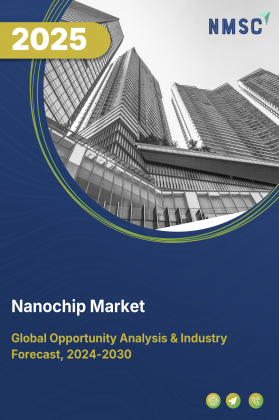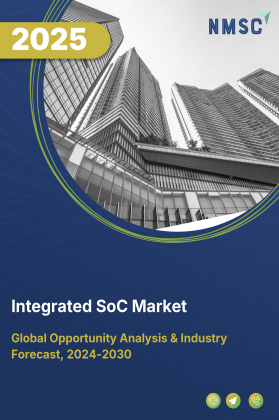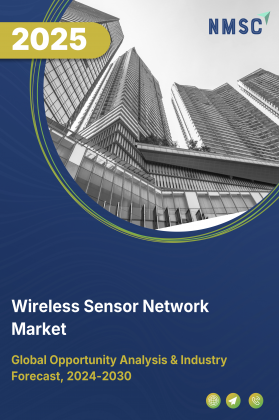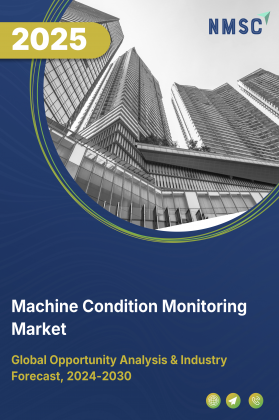
Nanochip Market by Material Type (Silicon-Based, Carbon-Nanotube-Based and Others), by Chip Architecture (CMOS & Silicon Nanoelectronics, Photonic & Opto-Nanochips and Others), by Product Form (Standard Integrated, Functionalized Lab-on-a-Chip and Others), by Application (Electronics & Computing, Healthcare & Life Sciences, and others), by End-User (Consumer Electronics, Medical Equipment, Automotive Systems, and Others) – Global Opportunity Analysis and Industry Forecast, 2025 – 2030
Industry Outlook
The global Nanochip Market size is estimated at USD 9.56 billion in 2024 and is expected to be valued at USD 10.83 billion by the end of 2025. The industry is projected to grow, reaching USD 20.13 billion by 2030, with a CAGR of 13.2% between 2025 and 2030.
The market includes highly miniaturized semiconductor chips designed at the nanoscale, capable of performing complex computations and data processing with exceptional speed and efficiency. These chips, leveraging nanotechnology, are integral to applications in electronics, healthcare, biotechnology, and computing due to their small size, high performance, and energy efficiency.
Nanochips are crucial in enabling advancements in next-generation devices, such as wearable technology, implantable medical devices, and quantum computing systems. Their importance lies in their ability to enhance processing power and functionality while reducing space and energy consumption, positioning them as a key enabler in the evolution of modern technology across various sectors.
Growing Demand for HPC And AI Applications Drives Market Growth
The rise of AI, ML, and HPC workloads fuels demand for nanochips offering massive compute and low power consumption. The global semiconductor industry is projected to surpass USD 1 trillion in annual revenue by 2030, buoyed largely by AI investments, with firms pouring ~USD 1 trillion into new fabrication through 2030. DOE notes that advanced nanochips are essential for AI, quantum, and HPC systems. Companies like Intel and TSMC are heavily investing in advanced nodes (7nm, 5nm, and below), directly addressing these compute demands.
Miniaturization Boosts Nanochip Adoption Across IoT, Wearables, And Edge Devices
Miniaturization is a key driver of the nanochip market growth, enabling the integration of highly advanced functionalities within increasingly compact form factors. As demand grows for lightweight, power-efficient, and high-performance devices, particularly in the Internet of Things (IoT), wearable technology, and edge computing sectors, nanochips offer the ideal solution due to their reduced size and enhanced processing capabilities.
Smaller chips not only allow more components to be embedded into limited spaces but also contribute to energy efficiency, faster data processing, and improved device portability. This trend is accelerating the deployment of nanochips in a wide array of applications, from smartwatches and fitness trackers to autonomous sensors and edge AI devices, thereby significantly expanding market opportunities.
Automotive and Autonomous Vehicle Integration Drives Nanochip Market Demand
The rapid advancement of automotive technologies, especially in electric vehicles and autonomous/ADAS platforms is significantly accelerating the demand for nanochips. These vehicles require ultra-compact, high-performance semiconductors to support real-time data processing, low-latency decision-making, and energy-efficient operation.
Nanochips are crucial for enabling features such as object detection, vehicle-to-everything (V2X) communication, and battery/powertrain optimization. For example, Texas Instruments launched the AWR2544 77 GHz millimeter-wave radar sensor, engineered for satellite radar architectures that enable vehicle sensing beyond 200 m, along with the DRV3946-Q1 and DRV3901-Q1 driver chips, which support functional-safety-compliant battery management and powertrain control systems.
High Research and Production Costs Limits Nanochip Market Expansion
Developing and scaling advanced nanochips demands expensive lithography systems, specialized clean-room infrastructure, and rare materials placing a heavy financial burden on companies. These high production costs restrict participation by smaller firms and hinder widespread adoption. A report highlights that despite projected global fab investments of USD 1 trillion by 2030, cost and supply chain challenges remain significant barriers to growth. Without meaningful cost reductions, innovation risks becoming concentrated among large incumbents, slowing overall market progress.
3D Chip Stacking and Chiplet Architectures Unlocks New Growth Opportunities for the Market
The emergence of 3D chip stacking and chiplet architectures presents a significant opportunity for the market by enabling higher performance, greater functionality, and improved scalability within compact footprints. These advanced packaging techniques allow multiple chip components to be vertically or horizontally integrated, reducing signal delay and enhancing data transfer speeds while optimizing space and power efficiency.
As demand increases for miniaturized, high-performance devices across sectors like AI, cloud computing, and edge processing, nanochips play a critical role in making these architectures feasible. The shift toward modular chiplet-based designs also allows manufacturers to mix and match specialized functions, accelerating innovation while lowering production costs. This creates vast growth potential for nanochip developers involved in advanced integration technologies.
Market Segmentations and Scope of the Study
The nanochip market report is segmented on the basis of material type, chip architecture/technology, product form/offering, sales channel, application, end-use industry, and region. On the basis of material type, the market is divided into silicon-based nanochips, carbon-nanotube-based nanochips and others. On the basis of chip architecture/technology, the market is segmented into CMOS & silicon nanoelectronics, photonic & opto-nanochips and others. On the basis of application, the market is divided into electronics & computing, healthcare & life sciences and others. On the basis of end-user industry, the market is distributed into consumer electronics, medical equipment, automotive systems, and others. The regional breakdown includes regions such as North America, Europe, Asia-Pacific, and the Rest of the World (RoW).
Geographical Analysis
North America is the current hub of advanced nanochip development, led by TSMC, Intel, and Samsung. TSMC is investing approx. USD 165 billion across three fabs in Arizona including Phase 1 volume production at Fab 21 and plans for two more supported by USD 6.6 billion in U.S. Chips Act grants.
Similarly, Samsung also received USD 6.4 billion in U.S. subsidies to support its Texas fabs in Taylor and Austin. With a projected higher CAGR in fab construction projects in the Americas, North America is set to maintain regional dominance through 2030.
Europe is focusing on semiconductor sovereignty under the Chips Act, aiming to increase production from 10% to 20% of global chip output by 2030. TSMC broke ground on a USD 1.14 billion fab in Dresden, Germany, targeting 40,000 wafers/month by 2027, in partnership with Bosch, Infineon, and NXP. Imec secured USD 2.72 billion in May 2024 to build a beyond 2 nm NanoIC pilot line in Belgium. The region’s CAGR for fab projects is growing steadily, with Europe tied for third in new fabs starting in 2025.
On the other hand, Asia-Pacific remains the global manufacturing hub for nanochips, led by strong activity in Taiwan, South Korea, and Japan. TSMC continues to advance its process nodes domestically while expanding its global footprint through overseas fabs. In South Korea and Japan, Samsung is pushing forward with 2 nm and 1.4 nm technologies, supported by high GAA transistor yields and international collaborations, including its Taylor, Texas facility. Meanwhile, Japan’s Rapidus, supported by industry giants like Toyota, Sony, and SoftBank is developing a 2 nm chip plant targeted for 2027, with a pilot line expected by 2025. With this momentum, Asia-Pacific is projected to dominate global nanochip production through 2030.
Emerging regions, largely North Africa, South America, and parts of MENA, are developing nascent ecosystems focusing on mature nodes and IoT chips. While no major nano fabs are underway, countries are offering incentives aligned with Europe’s model. RoW CAGR is modest through 2030, but initiatives are evolving, with governments expressing interest in attracting packaging and assembly operations.
Strategic Analysis Adopted by Key Players
The global giants such as GlobalFoundries, Intel, and Samsung are actively pursuing strategic investments, technological advancements, and public-private partnerships to strengthen their positions in the nanochip industry.
-
In June 2025, GlobalFoundries announced a USD 16 billion U.S. investment to expand manufacturing and advanced packaging at its New York (Malta) and Vermont sites. This includes over USD 13 billion to modernize existing facilities and USD 3 billion+ dedicated to R&D in packaging innovation, silicon photonics, and GaN.
-
In November 2024, Intel secured USD 7.86 billion in CHIPS Act funding for U.S. site expansions and positioned Intel 18A into high-volume production by 2025. In September 2024, it also strengthened a multi-year, multi billion-dollar partnership with AWS to produce custom AI fabric chips on Intel 18A/3 nodes, reflecting its foundry pivot.
-
In June 2024, Samsung’s AI-related foundry revenue surged by 80%, driven by close collaboration with ecosystem partners, including integration of chiplet and co-packaged optics (CPO) architectures
-
In April 2024, TSMC Arizona signed a preliminary memorandum under the U.S. CHIPS Act for up to USD 6.6 billion to support three advanced fabs in Phoenix, including a 2 nm facility, representing the largest-ever foreign direct investment in Arizona and securing domestic supply for AI, 5G, and high-performance compute markets.
Key Benefits
-
The report provides quantitative analysis and estimations of the sector from 2025 to 2030, which assists in identifying the prevailing market opportunities.
-
The study comprises a deep-dive analysis of the current and future nanochip market trends to depict prevalent investment pockets in the industry.
-
Information related to key drivers, restraints, and opportunities and their impact on the market is provided in the report.
-
Competitive analysis of the key players, along with their market share is provided in the report.
-
SWOT analysis and Porters Five Forces model is elaborated in the study.
-
Value chain analysis in the market study provides a clear picture of roles of stakeholders
Nanochip Market Key Segments
By Material Type
-
Silicon-Based Nanochips
-
Carbon-Nanotube-Based Nanochips
-
Graphene-Based Nanochips
-
Quantum-Dot-Based Nanochips
-
Others
By Chip Architecture / Technology
-
CMOS & Silicon Nanoelectronics
-
Photonic & Opto-Nanochips
-
MEMS / NEMS Sensor Nanochips
-
Bio-Nanochips
-
DNA Chips
-
Protein Chips
-
Lab-on-a-Chip / Organ-on-a-Chip
-
-
Self-Assembly & Printed Nanochips
By Product Form / Offering
-
Standard Integrated Nanochips
-
Functionalized Lab-on-a-Chip Platforms
-
Research & Academic Kits
By Sales Channel
-
Direct Sales
-
Distributors & Resellers
-
Online platforms
By Application
-
Electronics & Computing
-
Healthcare & Life Sciences
-
In-Vitro Diagnostics
-
Regenerative Medicine / Implantables
-
-
Automotive & Transportation
-
Energy & Environment
-
Industrial & Defense
-
Academic & R&D
-
Telecommunications
By End-Use Industry
-
Consumer Electronics
-
Medical Equipment
-
Automotive Systems
-
Aerospace & Defense
-
Environmental Protection Equipment
-
Solar & Energy Systems
-
Others
By Region
-
North America
-
The U.S.
-
Canada
-
Mexico
-
-
Europe
-
The UK
-
Germany
-
France
-
Italy
-
Spain
-
Denmark
-
Netherlands
-
Finland
-
Sweden
-
Norway
-
Russia
-
Rest of Europe
-
-
Asia-Pacific
-
China
-
Japan
-
India
-
South Korea
-
Australia
-
Indonesia
-
Singapore
-
Taiwan
-
Thailand
-
Rest of Asia-Pacific
-
-
RoW
-
Latin America
-
Middle East
-
Africa
-
KEY PLAYERS
-
Tower Semiconductor Ltd.
-
Intel corporation
-
DB HiTek Co., Ltd.
-
Hua Hong Semiconductor
-
Micron Technology, Inc.
-
SK Hynix Inc
-
Rapidus Corporation
-
GlobalFoundries
-
Semiconductor Manufacturing International Corporation (SMIC)
-
United Microelectronics Corp. (UMC)
-
Texas Instruments
-
STMicroelectronics
-
Advanced Micro Foundry
REPORT SCOPE AND SEGMENTATION:
|
Parameters |
Details |
|
Market Size in 2025 |
USD 10.83 Billion |
|
Revenue Forecast in 2030 |
USD 20.13 Billion |
|
Growth Rate |
CAGR of 13.2% from 2025 to 2030 |
|
Analysis Period |
2024–2030 |
|
Base Year Considered |
2024 |
|
Forecast Period |
2025–2030 |
|
Market Size Estimation |
Billion (USD) |
|
Growth Factors |
|
|
Countries Covered |
28 |
|
Companies Profiled |
15 |
|
Market Share |
Available for 10 companies |
|
Customization Scope |
Free customization (equivalent up to 80 working hours of analysts) after purchase. Addition or alteration to country, regional, and segment scope. |
|
Pricing and Purchase Options |
Avail customized purchase options to meet your exact research needs. |

















 Speak to Our Analyst
Speak to Our Analyst

























